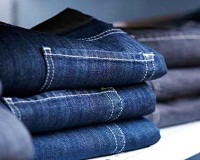"Lot has been said and debated on the usage of water that is required to produce a single pair of jeans. It takes more than 900 gallons of water to produce a single pair of denim jeans using conventional practices. That’s equivalent to a faucet left running for 15 hours, flushing the toilet 128 times in a row, or five years’ worth of drinking water for one person. All these are startling facts when water has become a scarce commodity. Therefore, water-saving measures are a must for the textile industry. Denim mills and chemical manufacturers have been consciously making efforts to find new water-saving dyes, waterless or near-waterless processes or manufacturing facilities equipped with technology to reduce water consumption. "

Lot has been said and debated on the usage of water that is required to produce a single pair of jeans. It takes more than 900 gallons of water to produce a single pair of denim jeans using conventional practices. That’s equivalent to a faucet left running for 15 hours, flushing the toilet 128 times in a row, or five years’ worth of drinking water for one person. All these are startling facts when water has become a scarce commodity. Therefore, water-saving measures are a must for the textile industry. Denim mills and chemical manufacturers have been consciously making efforts to find new water-saving dyes, waterless or near-waterless processes or manufacturing facilities equipped with technology to reduce water consumption.
Levi Strauss & Co say they are only responsible for about a tenth of the water consumed in the entire lifecycle of a pair of jeans; cotton cultivation and consumer care use the most amount of water. Nuria Estape, Head, marketing and promotion of textile specialties at Swiss chemical company Archroma, points out water scarcity is unfortunately already a harsh reality in some parts of the world. The most responsible brands and players in the textile industry fully acknowledge this reality and, under their leadership, impetus and initiatives, the entire industry is slowly but surely turning to more sustainable practices.
Sustainable steps by brands

Levi’s created Water Less, a set of standards and tools that removed up to 96 per cent of the resource from the denim finishing process. For instance, instead of using a lot of water and detergent to achieve a stonewashed look, Levi’s discovered how to get the same result using ozone gas. Patagonia reduced its reliance on the resource by 84 per cent after swapping out synthetic indigo dye for low-impact alternatives that adhere more easily to cotton. Similarly, Eileen Fisher worked with its Los Angeles jeans factory to develop two new washes, Utility Blue and Indigo, that both use 62 per cent less water than the brand’s most intensive wash.
Meanwhile mills and suppliers are also taking initiatives. Hong Kong-based Trusty Trading, a waistband and pocketing specialist partnered Archroma to create a Eco Pocketing range. With Archroma’s near-waterlesss Optisul C dyes, it was able to reduce water usage by 94 per cent, while also increasing speed to market. Archroma offered two eco-friendly dyeing processes under its Advanced Denim concept, Denim-Ox and Pad/Sizing-Ox, since 2009. By using sulfur dyes instead of indigo, traditional dyeing ranges comprising 15 vats are replaced with systems that use no more than five vats.
Jeanologia has been working with ozone finishing for more than 15 years and introduced its G2 washing machine in 2008, which uses oxygen and ozone gas instead of water and toxic processes to give jeans an aged look. As per the firm, G2 cuts water consumption by up to 70 per cent and chemical usage by up to 80 per cent. Carmen Silla, Marketing Manager, Jeanologia says technology minimises water consumption and chemicals, eliminates waste and reduces energy in all processes.
In line with this, Mexico-based mill Global Denim recently launched a zero-discharge dyeing process called Ecolojean that uses less water and energy than conventional methods required to dye one pair of jeans. Anatt Finkler, Creative Director, Global Denim, says instead of passing the denim or thread through water vats and dyeing vats, Ecolojean process only puts them through dyeing vats and the dye bonds to the fabric without having to go in the water. When you dye conventionally, as much as 25 per cent of the dye ends up in the water, but with Ecolojean, 100 per cent of the dye that’s applied remains on the yarn.
Kaltex will release Aqueduct in Autumn/Winter18, a collection of fabrics created using water-saving practices such as a dyeing system that eliminates rinsing in fabric production. Jadel Lam, managing director – R&D, Kaltex, informed that they are constantly looking, researching and investing in new technologies that aid in reducing water, energy and chemical usage.
Cost an added burden?
As a general belief, consumers do not want to pay more for something that is the manufacturer’s responsibility. Arpit Srivastava, Marketing Manager, Arvind feels it’s worth it. With water becoming a depleting resource, this is the future of the denim industry. Another hypothesis on the way of sustainability is that the product quality will diminish, but it has been made clear by experts that there is no aesthetical difference between denim dyed or finished using eco-friendly methods and denim treated using large amounts of water and chemicals. Alvyda Kupinas, head – design, Kaltex, reiterated that safe and sustainable does not require sacrificing aesthetics or quality.












